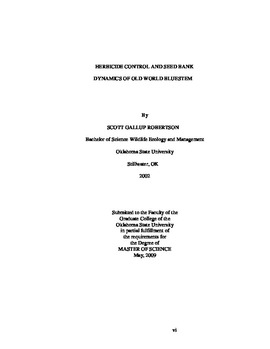| dc.contributor.advisor | Hickman, Karen R. | |
| dc.contributor.author | Robertson, Scott Gallup | |
| dc.date.accessioned | 2014-04-15T22:06:19Z | |
| dc.date.available | 2014-04-15T22:06:19Z | |
| dc.date.issued | 2009-05-01 | |
| dc.identifier.uri | https://hdl.handle.net/11244/9361 | |
| dc.description.abstract | The invasive grass Old World bluestem (OWB Bothriochloa ischaemum) threatens native plant and animal diversity. I used single, double, and triple applications of glyphosate in various combinations with and without a mowing or burning to determine the most effective treatment for controlling OWB for future restoration. Also I assessed the affects of OWB invasion on native species diversity and abundance of the aboveground plant community and seed bank community. One year after treatment, burning and mowing prior to a single herbicide application improved the amount of OWB control compared to a single herbicide treatment. Burning or mowing with two herbicide applications provided more OWB control relative to plots that received only two herbicide application. The burn and mow double herbicide treatments did not exhibit an increase in reproductive tiller density or visual obstruction a year after treatment, whereas plots that received only two herbicide applications did. Burning or mowing with two herbicide treatments provided similar amounts of OWB control compared with the triple herbicide treatment. Combining burning or mowing with herbicide applications provided more effective OWB control than the herbicide only treatments. Regarding the seed bank, native aboveground species diversity and cover showed a steep declined as OWB cover increased. There was a slight decline in native seed diversity, and no change in native seed density as invasion increased. OWB seed density increased with increasing invasion. I hypothesize that as OWB invasion increases native aboveground plants decrease in diversity and abundance, but native seed bank diversity and density does not decline, but over time as native seeds are lost, and the lack of native seed replenishment from the aboveground community, native seed bank diversity and density will decline. | |
| dc.format | application/pdf | |
| dc.language | en_US | |
| dc.publisher | Oklahoma State University | |
| dc.rights | Copyright is held by the author who has granted the Oklahoma State University Library the non-exclusive right to share this material in its institutional repository. Contact Digital Library Services at lib-dls@okstate.edu or 405-744-9161 for the permission policy on the use, reproduction or distribution of this material. | |
| dc.title | Herbicide Control and Seed Bank Dynamics of Old World Bluestem | |
| dc.type | text | |
| dc.contributor.committeeMember | O'Connell, Timothy J. | |
| dc.contributor.committeeMember | Leslie, David M., Jr. | |
| osu.filename | Robertson_okstate_0664M_10209.pdf | |
| osu.college | Agricultural Sciences and Natural Resources | |
| osu.accesstype | Open Access | |
| dc.description.department | Department of Plant and Soil Sciences | |
| dc.type.genre | Thesis | |
| dc.subject.keywords | bothriochloa ischaemum | |
| dc.subject.keywords | burning | |
| dc.subject.keywords | glyphosate | |
| dc.subject.keywords | invasive control | |
| dc.subject.keywords | mowing | |
| dc.subject.keywords | seed bank | |
